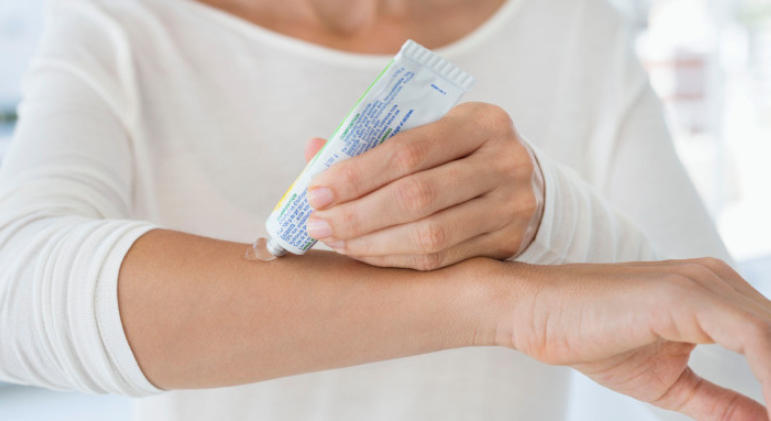Bed bug bites may be confused with bites from other insects. Bed bug bites are rarely dangerous, but they can be extremely itchy. Infection and allergic reactions may also occur. Learn more about bed bug bites, symptoms, treatment, and prevention at the end of the article.

The bed bug:
The bed bug is a small, flat, oval-shaped insect with a reddish-brown color that feeds on blood. Bed bugs are about the size of an apple and can live in bedding, furniture, carpets, and clothing. Carbon dioxide and body temperature attract bed bugs. Therefore, bed bugs are most active at night in the parts of your house where you sleep, and hide during the day in the same places where they bit you the night before.
Humans and animals transport bedbugs from one place to another since they don’t have wings. In most cases, bed bugs enter your home by traveling at night and attaching themselves to your clothing or luggage. Furthermore, bed bugs can spread to nearby buildings if the building or hotel you are in is infested with them.
Bed bug bites cause the following symptoms:
Before feeding, bed bugs secrete a numbing substance, so you won’t feel the bite, and symptoms may appear a few days later. There are 30 to 60% of people who do not notice the symptoms of bed bug bites. Bed bug bites can cause the following symptoms:
A red or swollen bite with a black spot in the center (may resemble a blister);
Several bites arranged linearly or clustered together;
itching;
burning;
Blisters filled with fluid;
Blood stains are visible on the sheet as a result of itching at the bite site.
Treatment for bed bug bites:
In most cases, bed bug bites heal within a week or two. These drugs can help you get rid of the symptoms:
Reduce inflammation and itching with over-the-counter and prescription steroid creams;
Reduce itching and burning with oral antihistamines or diphenhydramine cream;
Swelling and pain can be reduced with over-the-counter pain relievers;
Antiseptic lotion or topical or oral antibiotics for bacterial infections;
Bites from bed bugs can be treated at home in the following ways:
Besides over-the-counter medications, there are several home remedies for bed bug bite symptoms, including:
Wrap an ice pack in a towel or use a cold cloth;
On the bite site, apply a thin layer of baking soda and water paste.
Infection from bed bug bites and allergic reaction:
In rare cases, bed bug bites can cause an allergic reaction. Hives, asthma, and anaphylactic shock are some of the symptoms of allergies. The constant scratching of bed bug bites can cause secondary infections such as impetigo, folliculitis, and cellulitis. In order to reduce the risk of infection, wash the bite site with soap and water and avoid scratching it.
If you suspect an infection or allergic reaction, consult your doctor. If you experience any of the following symptoms, you should seek emergency medical attention:
breathing problem;
wheezing;
swelling of the throat or mouth;
Fever;
chills;
dizziness;
confusion
Bed bug bite prevention:
Bed bugs can survive for a long time without food and can be transferred from one place to another by sticking to luggage and clothes. Follow these tips to prevent bed bugs from entering your home:
After traveling, you can use mechanical methods such as vacuuming, heating, cooling, and freezing to clean things to prevent bringing bed bugs home.
In a hotel or while traveling, keep your clothes in your suitcase, not on the floor.
Put your luggage away from your bed when you return from your trip and wash your clothes in the washing machine before putting them back on.
Put non-washable items in plastic bags after returning home from a trip.
Heat your luggage if you travel frequently.
Before entering the house, check used items and clothes.
Insect bites differ from bed bug bites in the following ways:
Bite of a flea: The bite of a flea is much smaller than the bite of a mosquito. Red rashes and itchy rashes are caused by both. The majority of flea bites occur on the lower parts of the body and warm, moist areas near joints, while bed bugs bite mostly on the upper parts of the body.
The bites of mosquitoes are red, swollen, and itchy. It is probably bed bug bites if you have a line of bites. There is no specific pattern to mosquito bites. Within one to two weeks, both bites usually heal on their own.
The sting of a bee may be enlarged due to an allergic reaction or other reasons, and it usually itch like a bed bug sting. Bee stings are usually enlarged, shaped differently, or located differently at the site of the sting.
Like a bed bug bite, a spider bite is red and itchy. Unlike bed bugs, spiders rarely bite more than once. If you only have one bite, it probably isn’t a bed bug bite. Bed bug bites usually heal faster than spider bites. Spider bites can cause serious skin damage and infection, and some are poisonous.
Frequently asked questions:
1. Bedbugs bite where?
Any part of the body can be bitten by bed bugs. While sleeping, it usually bites accessible areas of the skin. The face, neck, arms, and hands are included. The bug will bite along the clothing line if you wear pajamas.
2. Every night, do bed bugs bite?
There is no need for bed bugs to eat every night. Bed bugs can live for several weeks without food. It may take weeks to discover that you have bed bugs in your home, or you may not notice them for a long time. Bed bugs multiply rapidly, which is a problem. A female bed bug can lay eggs once every three to four days.
3. What is the treatment for bed bug bites in children?
Check the sheets, mattress, bed and baseboards for bed bugs if you suspect your child has been bitten by bed bugs. Symptoms of bed bug bites in children can be relieved by using a cold compress, anti-itch cream, or weak non-prescription steroids. Cover the bite with a bandage and cut the child’s nails so he doesn’t scratch it.
4. What are the hiding places of bedbugs?
During the day, bed bugs hide in a variety of places in the house, including:
cracks and fissures;
Walls;
Luggage;
Sleepwear;
mattress;
bed spring;
bed frame;
Under the cornices;
Parts of the wallpaper that have been torn off;
light switch;
electrical cable conduit;
Sofa (if used for sleeping).
In addition, bed bugs are usually found in high-traffic areas and crowded buildings. Included are:
Hotels;
Hospital;
shelter for homeless people;
Garrison;
Dorm;
apartment complexes;
Commercial office.
It is also possible to transmit bed bugs by bringing second-hand items or meeting people who have bed bugs.
5. What is the best way to get rid of bed bugs?
Here are some ways to get rid of bed bugs:
Cleaning the floor, mattresses, and furniture with a vacuum cleaner and steam cleaner.
Make sure the washing machine is set to the hottest setting when washing sheets and clothes.
The house’s cracks and seams need to be filled.
Bed bugs cannot be eradicated without insect repellants. Many insect repellants today use non-chemical ingredients such as extreme heat or liquid nitrogen to repel insects. Since bed bugs are resistant to many insecticides, these products can be effective.


